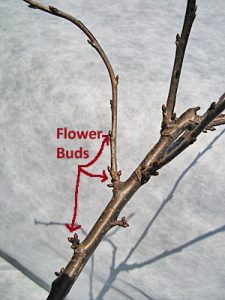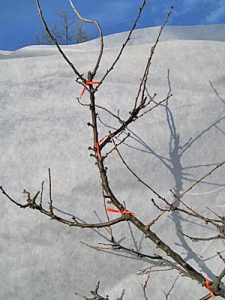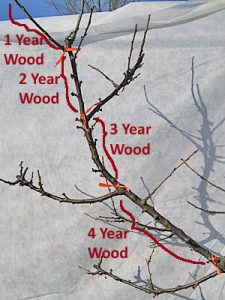One important note: always prune cherries when you will have at least 2 days of dry weather. This can help reduce canker.
Most people grow sweet cherries as freestanding ‘bush’ shaped trees. In a future post, we’ll talk about growing sweet cherries as an espalier or fruiting wall form called UFO (upright fruiting offshoot).
Cherry trees produce stiff and fairly upright branches. Growing cherries as an open center (bush) tree will keep the height down making for easier pruning and picking. These trees will end up wider and paying attention to potential shading issues will be important in maintaining a healthy tree. There are several basic cuts and principles with cherries that you will use over and over. For the most part you are using the same principles as with peaches, you just don’t prune quite so much out on an annual basis.
Keep in mind while reading this that your goal is to prune your trees to keep them healthy- open them to light, to keep the larger wood low in the tree, and to promote fruit wood.
In developing the cherry tree shape and form you will want to develop 3 to 4 main upright branches that will become the main leaders of the tree. Most nursery trees will not have 3 plus upright leaders (shoots). Often a young cherry tree is just an whip with no branches. The first year you will cut the main leader or leaders down to about 20-30 inches. This height will depend on how you are going to maintain the grass around the tree; meaning how much room do you need for your lawnmower. Don’t worry if there is only one or two shoots. Prune them all back and they will give you plenty of choices next year.
Cherries have the propensity to produce shoots that continue to elongate and that do not push side branches. You can’t let this happen! As these main leaders grow in early summer, make a heading cut into the main leaders every 2 or 2 1/2 feet . Or if the branches have grown this distance by August 1 (or anytime before then), pinch out the terminal bud. Continue to do this until the shoot produces several side shoots. Then let the shoot grow another 2 feet or so and repeat the process. If these shoots are not growing vigorously then it is better to wait and dormant prune these shoots. You don’t want any more than four uprights.
In 2-3 years you should have a small but nice sized fruit tree. You could see blossoms on your trees in the second year and certainly in the third year on most varieties.
- Sweet cherries can have flower buds on 1 year old wood as well as older wood. Often you will get good flower buds right at the base of vigorous 1 year wood. Branches that have flower buds near the tips should be headed back; essentially thinning the fruit through pruning.
- Unpruned Sweet Cherry branch. Ribbons mark each year’s growth.
- Same branch, pruned. If a caliper reduction was need here, you could cut back to the base of the 3 Year wood.
How do we manage quantity of fruit so we can get good size and high sugars in our cherries?
There are a couple of fairly easy steps to achieving this goal. Both factors we will talk about have to do with ways to thin fruit.
- The first way is something you can do at pruning time: Tip the new growth from last year by roughly 25%. All the buds you left last year on that shoot will turn into flower buds and, with pollination, fruit in the second year. Go out and before you prune, count how many buds are on several of your one year shoots. Typically you will see nearly half the buds are in the top 25% of the shoot. So by tipping 25% of those shoots you have already reduced your crop by 30-50%. Cherries grown on Gisela rootstocks are very heavy bearers, and must be thinned by 50% to 75% in their ‘on’ years. You will see in the photograph an example of pruning one year old shoots . Cherries bear fruit at the base of a one year old shoot as well.
- The second technique for maintaining quality is stripping off all the spurs on the underside of the branch. Remember this should only be done when the weather is dry. By taking these spurs off, you have providedthe necessary air space for the cherries that will hang of either side of the branch. Another advantage of this method is removing the fruit that is most likely to rot in a wet year.
- So, you’re out in your yard, and looking at your cherry tree, you see a lot of vigorous, upright shoots. Upright shoots generally produce the largest fruits and the most sugars. If there are too many shoots, it is worth thinning these spurs by hand as long as you followed the above instructions and have tipped your one year old shoots.
Fruit Density
3-4 leaves per fruit is what is typically considered a successful ratio in commercial cherries. Because cherries ripen so early they need a little better management to produce larger and sweeter fruits. This is because the fruits are ripening just as the maximum growth spurt is happening in the tree.
Renewal Pruning
If you are working with older trees you should consider making some heading cuts into the 5-6 year old wood. As any cherry tree ages this will be a key practice to renew old wood with new wood that is closer to the trunk of the tree. The best fruits are grown on 2 to 4 year old wood. Cherry spurs are fruitful for many years; however by renewing branches every so often you can maintain tree size, vigor and quality in these productive trees. These renewal cuts are back in towards the trunk on the branch. You find side shoots that have 1-2 year old shoots and make the cut back to that point. For best results just prune out one of two of these aging branches a year. The tipping of the one year old wood described above should be done here as well.





It’s amazing how you can tell the age of a tree like this. Thanks for the great advice!
What do you mean by “heading cut”? How and when do you do it? A picture would be appreciated.
A heading cut shortens a branch without removing it. A thinning cut, in contrast, removes a branch.
1st year Cherry tree grown from a pip has leaves falling off and there are buds forming just above every leaf scar left from the fallen off leaf. are these buds for next season ie. cherries to come ??
They could be either leaf buds for next year (pointed buds) or flower buds (rounded buds). Grown from seed, I would not expect the tree to start fruiting very young.
Hello,
We planted a cherry tree pre-Covid in my elderly mothers yard. So unfortunately the tree has been neglected since. It is now a completely vertical, columnar shape with a thick leader and a few thick side shoots, also vertical. Should I now cut back the thick leader to 20-30 inches after fruiting and head back side shoots 25% or 2’ from the base of each side shoot?
Yes, if you are going for a bush shape tree, that sounds like a good plan. Make sure you prune when you will have at least 2 days of dry weather following your pruning cuts.
Just a note to those that have a hard time moving things or using dollies. I have my 2-year self-pollinating sweet cherry tree in a 35-gallon garbage can with wheels. This make it easy for me to move around, water and the can is black, or a light color if you have a lot of hot weather. I was thinking of painting the can so it looks more fashionable but not in any hurry. I do not plan on transplanting the tree either. I also have an apple, pear and many other trees in big containers. I live in zones 7a and 7b, with 5700 elevation.
I purchased a 6-7 ft tree from a popular online nursery and received a very long stick with leaves at the end of it. I’m concerned because there aren’t any branches, am I supposed to cut this down in order to get branches?
We have a sweet cherry tree that has been in 7-8 years with no pruning. How do we get under control to product reachable fruit. It is 20 ft high.
Can we cut off some of the main ranches to shorten it?
It depends a lot on both rootstock (dwarf?) and the wood caliper- if the branches are still relatively small caliper, they should resprout from being cut back hard. Timing would be during dry weather in spring after bloom. Too late in the summer and the tree might not grow again, and winter pruning is an invitation for disease.
Thank you for this very helpful information. I just summer pruned a Lapins cherry tree and the original central leader (about 1.5″ thick) has brown at the core. No branches have that. Is that normal?
I’m not sure without seeing. Was the leader healthy? Leafing out well? If so, probably normal.
I bought a self pollinating cherry tree in Southern California and it has grown to 7′ before it branched out ; it looks like a columnar tree. This tree is going on its third year on the ground and it has already grown 18′, no. I didn’t realize I have to head it every few feet as it grows; after I head to 1 feet from the ground when I got it. How do I get it down to 5′ or so; or could I? Could you suggest what I should Do. No fruits as yet. Thank you.
Your best bet is to cut the tree back hard at the beginning of your growing season. Hopefully you still have some growth or developed buds lower on the tree where it can regrow from. 5′ may be too small for a sweet cherry, particularly if it is not on a dwarfing rootstock; you will end up cutting off most of the fruiting wood to keep it that small. Since you haven’t had fruit yet, I wonder if you get enough chill hours for sweet cherry production in your climate. Your local master gardener extension group will be your best resource in that regard.